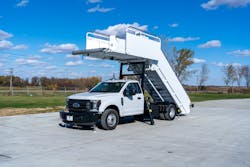Stepping into Innovation
Stinar designed the SPS-3518 in the 1970s as larger, wide-body aircraft sill heights approached 19 feet. Now, the stairway is used all over the world and offers features to suit many diverse types of operations.
“The SPS-3518 has a minimum floor height of 96 inches to 228 inches, which allows the stair unit full-service capabilities of almost all midsize to wide-body aircrafts all the way up to the B-747,” says Jason Johnson, vice president of business development for Stinar.
The stairway comes with several key features. The 48-inch stairways feature embossed diamond tread steps and stainless-steel handrails.
Dual hand controls, proximity sensors, a cab-mounted operator’s camera for visual height adjustment and an electronic overspeed controller assist operators when maneuvering the stairs into position.
A PTO-driven hydraulic system, a PowerPack electrical backup, poly fenders and toolboxes, an extending platform and a front swivel bar bumper also come standard.
The SPS-3518 provides numerous safety features, too, including lock valves mounted on each pair of stabilizer hydraulic cylinders, a cab warning light to indicate stabilizer position, an A-frame locking mechanism, a back-up alarm, camera and an amber flashing beacon.
These safety features exist to assure customers there will be no chance of mechanical issues while using the stairs. The lock valves keep the cylinders from moving inadvertently in an extended position while the A-frame locking mechanism prevents the A-frame from descending should a hydraulic part fail.
The stairway is used globally by a range of customers.
“Literally all over the world, from the North Pole to down under, FBOs and MROs to armed forces bases, airplane manufacturing facilities to major airports,” Johnson says.
Lately, Stinar’s customer-base is migrating towards FBOs and government purchases, according to Johnson.
Johnson says customers must keep in mind geographic location, climate and traffic volume before making a purchasing decision.
“The biggest [consideration] of course is volume and type of aircraft. What accommodations do they have to offer? You need to get people on and off the aircraft in a safe and efficient manner. So yes, purchasers evaluate a multitude of variables when it comes to making a purchasing decision,” says Johnson.
Customers in colder climates have access to winterization packages for the SPS-3518.
“We offer a full winterization package on all our units,” explains Johnson. “We have found that mother nature is always unpredictable and a lot of times these units may change locations because of key factors in a customer’s operation. So, having a standard winterization package on the SPS-3518 assures our customers that if it gets cold, the hydraulic tank heater, transmission and engine block heater along with all the other features to our winterization package will keep their unit performing even in the harshest conditions.”
Stinar provides maintenance schedules and full operational manuals with their stair units to help customers get the most out of a purchase. Johnson says following maintenance guidelines will increase the longevity of the passenger stairs while the operational manuals help customers educate their staff on how to safely use the equipment.
“A full operational manual is provided in a weather-proof case, along with a digital version, which is standard now on all Stinar units and each new unit comes with enhanced training as well,” Johnson says. “We will provide training, both in-person and through operational videos so that our customers can educate their staff on the proper ways to operate all Stinar units.”
The company also makes it a point to listen to user feedback when making updates to keep their customers satisfied with the product.
“All these years this unit has been in service has given us tremendous knowledge and feedback from our customers. Durability, reliability, simplicity of use, customer service support, maintenance manuals and onsite training have all been a topic for discussion. They speak and we listen and over the years have taken their requests and made standard,” says Johnson.
Changes to the SPS-3518's design, since its inception 43 years ago, have relieved stress factors on certain areas, enhancing the durability of the product. Stinar has also improved hydraulic systems, electrical configurations and added safety valves to make the stairs more reliable.
Some optional features are available, Johnson notes. These include a passenger stairway canopy, custom colors and decals, choice of chassis and an option of diesel or gasoline.
Johnson says reorders prove that customers trust the SPS-3518 unit.
“One of the strongest forms of feedback we have seen is reorders, which speak for themselves. The continued improvement our customers notice from their first stair until to their last, the consistency they have come to expect goes a long way with most and they will absolutely voice their opinions in an industry like this if something is not to par,” says Johnson.
Stinar plans to continue updating the SPS-3518 moving forward.
“Updates are still continuously in the works for the stair trucks: improvements in efficiency, safety and manufacturing are things we never stop updating and improving on. One of the biggest updates we have coming is a complete electrical chassis unit,” Johnson says, adding that Stinar hopes to roll out the first electric chassis units in the fourth quarter of 2021.
Johnson is certain Stinar will be able to satisfy the needs of the aviation sector as the industry rebounds from the COVID-19 pandemic.
“We are actively building units now with the goal to have equipment on the ground with immediate delivery. Low lead times, reliability and consistency will keep our stair truck in the forefront of ground support,” he says. “When the industry rebounds, and it’s going to in a big way, people are going to want to get out and about again. When it does, we will be there to provide new units, help support and maintain current units and all Stinar units for that matter in the field today.”
